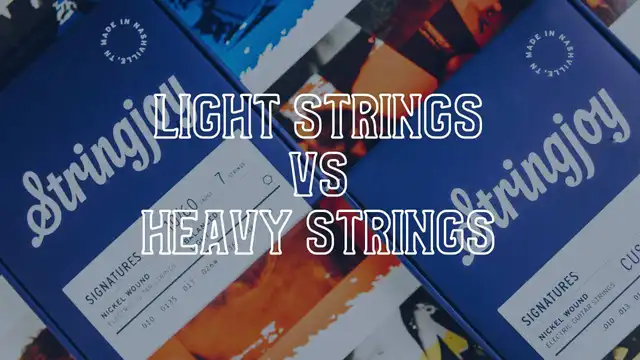Light Strings vs Heavy Strings: What Gauge is Right for You?


When it comes to developing your tone, you’ll find there’s a lot more to it than just buying a cool amp or a new guitar. You'll soon notice that even the smallest things can make a huge difference. From the order of your pedals to the thickness of your picks, it all matters.
One of the most important choices, however, is choosing the type of strings you’ll use.
While there are a few different materials to pick from, one of the first things you’re probably going to notice are the various sizes, or gauges, that strings are offered in. These sizes are most often defined as being Light, Medium, or Heavy gauge and there are some important differences between them all.
Light Gauge Strings
Because of their size, lighter-gauged strings are a wonderful choice for beginners since they are much easier to press down, but there are still plenty of big-name players out there who use light gauge strings exclusively.
With light gauge strings, the tone is, as you might have guessed, light, crisp, and clean. Country and Bluegrass pickers are huge fans of these and some even prefer to go as small as a .007, which is about the equivalent of playing angel hair.
The old faithful, and much more popular, .009’s and .010’s have been standard sizes for funk and rock 'n' roll players since the late 60s. One of the most influential guitarist of all time, Jimi Hendrix, preferred a custom set of .010’s on his guitars and was none too shy about telling other guitarists using anything else to ditch whatever they were using and follow his lead.
But as with everything, there are some drawbacks with lighter gauge strings. They do tend to wear down faster and break more easily than heavier strings for obvious reasons. Another con is their tendency to go out of tune when bent. So if you do a lot of single note soloing and bends are an integral part of your style, you'll want to keep a good tuner handy.
Heavy Gauge Strings
For some guitar players though, the only strings worth using are heavier gauge strings. Heavier gauge strings are great for those looking for a full, rich, booming tone with extra sustain and a big bottom end sound. They’re workhorses and you can generally count on them to stay in tune and intact far longer than lighter gauge strings. Heavier gauges are also a necessity if you are wanting to play in dropped tunings, because tuning down to C on a set of .008s just ain't gonna cut it. There's not nearly enough tension to make it happen.
They are harder on the fingers than lighter gauge strings, obviously, and it takes an experienced hand to play on thicker strings and not end up with sore fingertips and a constant buzzing sound. Once you get used to them though, they can end up being your best friend.
Blues legend Stevie Ray Vaughn is the most recognizable name on the list of famous guitarists who are known to use thick strings. If “The King of Tone” played on a .013-.058 set, then surely he knew the value of a heavier string.
SRV’s tone wasn't just the result of years of practice, playing thousands of gigs, and endlessly tinkering with different amps and effects. For all the amp combos and gadgets, the thing that stood out most of all might have been the massive strings he used. Even the heaviest strings available on the market were often not thick enough and he was known to special order sets by the carton just to get the exact size he wanted for each string.
What's right for you?
Choosing the right strings is an ongoing process for most of us, so don’t be afraid to explore. Try several different sets of various sized strings and see what you like best. You can always build and order custom sets from us if you want something truly unique.
Remember, nothing is more important than developing your own personal style and tone. The strings you choose, whether light, heavy, medium, or a custom mixed set, might just be what makes that sound truly your own.
Good luck!
Other Posts you may like

Guitar Strings Order: How the Guitar is Tuned and Why

Best Acoustic Guitar Strings for Beginners

Two Handed Tapping: Our Top 8 Tappers of All Time

Which Guitar Strings Wear Your Fret Wire Down More?

What is Nashville Tuning? Its History, Best Guitar Strings & Uses

Guitar Scale Length Explained: String Tension & Playability
0 Responses
Leave a Reply
Your email address will not be published. Required fields are marked *




